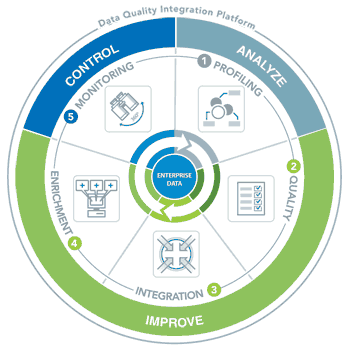LESSON - The Five Step Approach to More Valuable Enterprise Data
By Daniel Teachey, Director of Corporate Communications, DataFlux Corporation
Many organizations are implementing new strategies to get ahead of the competition. But they frequently ignore the quality of their underlying data, leading to poor decisions, insufficient customer service, and ultimately, lost revenue. Some of the reasons for the explosion of inconsistent, unusable data include human error, poorly structured data entry procedures, and a lack of data standards across business units.
Before you begin any new data-driven initiative—such as enterprise resource planning (ERP) or customer relationship management (CRM)—it’s important to address data quality issues within your existing data sources and to prevent your data from becoming outdated.

The Five Components for Data Improvement
Technology currently exists that allows businesses to improve and consolidate corporate information on an ongoing basis. This proven five-step data quality process helps these businesses analyze, improve, and control their data across the enterprise:
1. Data Profiling. Prior to building a house, an architect creates a detailed blueprint of the structure. Unfortunately, most data quality projects don’t take this same approach to building better data. Data profiling helps you determine the current state of your data and allows you to discover problems with the data—including content, structure, and relationship problems across columns and tables. By understanding the strengths and weaknesses of your data, profiling gives you a starting point for making substantial improvements.
2. Data Quality. If data profiling provides a blueprint of data problems, the data quality phase begins the process of building better data. With data quality, you can correct errors, standardize information across tables, and validate information that is inconsistent and inaccurate. Common data quality tactics include data standardization, pattern standardization, and address verification.
3. Data Integration. Data about the same item often exists in multiple databases. This applies to virtually any type of data (e.g., customer data or product data). Once you have standardized and corrected data quality issues, you can more easily integrate this data across different sources. Data integration technology helps you intelligently integrate customer, product, and other kinds of business data across multiple sources.
4. Data Enrichment. Data enrichment builds on data quality and data integration by enhancing it with additional information and incorporating additional external data. With data enrichment technology, customer data can be combined and segmented more effectively to identify specific opportunities. Product, inventory, or financial data can be enhanced by adding additional bits of information from external sources. With data enrichment, you can create more valuable corporate information.
5. Data Monitoring. Organizations often believe their data quality problems are solved once they have improved existing data sources. However, maintaining high-quality data requires ongoing vigilance. Data monitoring allows you to create and enforce customizable, automated business rules to check the level of data quality over time. These rules, stored in a business rules repository and replicated across the enterprise via Web services, allow you to enforce data governance rules and customize rules to be consistent with your operational processes.
Five Steps. One Platform.
The quality of any business analysis is only as good as the data at its foundation. Without data that is consistent, accurate, and reliable across the enterprise, an organization can easily reach misleading and potentially harmful conclusions.
With breakthroughs in technology, what was once an overwhelming endeavor can now be a streamlined data quality management process that is much less time-consuming, difficult, and costly. When implementing a data quality improvement program, look for a technology that can accomplish the five phases described here—all from the same interface. With a comprehensive platform of data improvement technology, an organization can elevate the role of data quality to an ongoing corporate activity, enabling better business decisions and a more competitive enterprise.
This article originally appeared in the issue of .